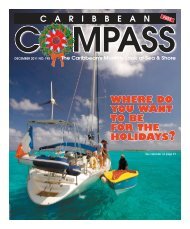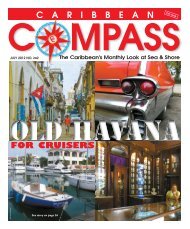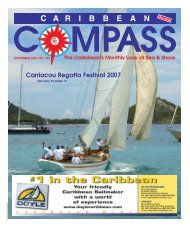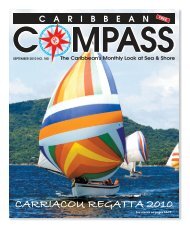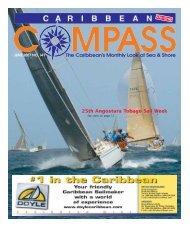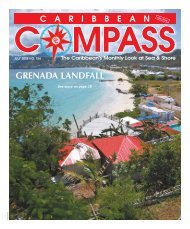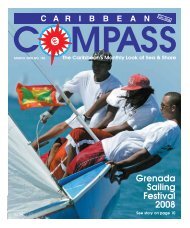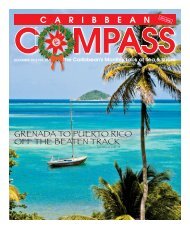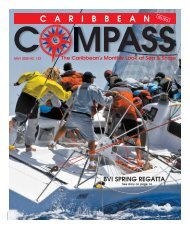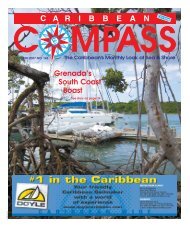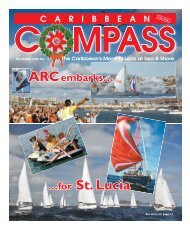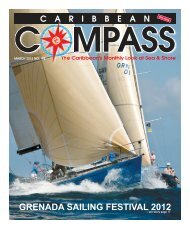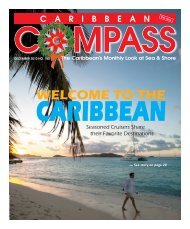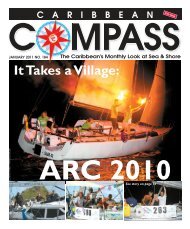You also want an ePaper? Increase the reach of your titles
YUMPU automatically turns print PDFs into web optimized ePapers that Google loves.
JANUARY 2008 CARIBBEAN COMPASS PAGE 20<br />
Le Marin<br />
DOCK, BAR<br />
&<br />
RESTAURANT<br />
Open 7/7 VHF: 16/68<br />
• deep water stern-to berth<br />
• water/ice/laundry<br />
• tel+fax+internet<br />
• gas station<br />
CUSTOMS CLEARANCE<br />
Tel: (+) 596 596 66 05 45<br />
gas station: (+) 596 596 66 17 30<br />
e-mail: leponton@wanadoo.fr<br />
14˚33N - 61˚03W<br />
POINTE DU BOUT, MARTINIQUE<br />
THE<br />
SPECIALIST<br />
FOR<br />
BOAT<br />
MAINTENANCE<br />
IN MARTINIQUE<br />
Zinc Anodes<br />
Plumbing<br />
Marine Paints<br />
Batteries<br />
Epoxy<br />
Antifouling<br />
Centre de Carenage 97290 Le Marin<br />
Tel: +596 (0) 596 74 74 80 Fax: +596 (0) 596 74 79 16 carene.shop@wanadoo.fr<br />
—Continued from previous page<br />
So, the plan was set and we flew out of Antigua on the sea-grid search flight with<br />
Norman Aviation on the morning of 20th February 2007. Ann Louise was pressganged<br />
into being the starboard-hand spotter.<br />
Some will say we were lucky (and we were, because the sea was like glass on this day)<br />
but I still take off my hat to Hugh Agnew, navigator extraordinaire. On our first run up<br />
the search grid, flying at 1,000 feet, Ann Louise spotted a yacht soundly afloat on the<br />
starboard side of the aircraft some 15 miles south of the predicted position. Closer circling<br />
at lower altitudes proved the vessel she had spotted was indeed the Arnolf, now at<br />
position 17.50°N, 50.04°W. After a few low passes we returned to Antigua.<br />
I reported to the underwriters in Europe that we had located the yacht some 280<br />
miles northeast of Antigua and that the present drift direction would eventually take<br />
the yacht north of Barbuda.<br />
Their next proposal took me slightly unawares: would I be prepared to put to sea<br />
and tow the vessel back to port? This was quite an undertaking; we mulled over the<br />
logistics of any such rescue attempt.<br />
After some discussion, Ann Louise and I decided that we had a reasonably good<br />
chance of success. Firstly, we have an early Najad 16.50m sailing yacht that has two<br />
80-horsepower engines, unusually powerful motoring muscle for a sailing yacht of<br />
her size. (We also have two very strong stern Sampson posts for towing.) Secondly, we<br />
had a really good fix on where the vessel was. Thirdly, the weather was as calm as I<br />
had ever seen it in the <strong>Caribbean</strong>. We rushed to prepare, bearing in mind we would<br />
have to tow a highly unstable vessel over a distance of some 200 miles. I engaged two<br />
extra crew to help: one a highly experienced captain, the other a strong young deckhand.<br />
The insurers also agreed to indemnify us in case of any accidents.<br />
We put to sea late afternoon on 22nd February. En route I got down to some serious<br />
planning on the sat phone with Hugh Agnew in London, trying to decide our best<br />
approach to any new predicted position of the vessel. Correlating all the information<br />
we had, we reckoned we had a very good chance of intercepting the vessel on an<br />
accurately predicted drift line. Strange as it may seem, vessels adrift are far more<br />
influenced in their direction by current than they are by any wind.<br />
Arnolf is spotted from the air on 20th February, 2007, some 280 miles<br />
northeast of Antigua<br />
We reached our predicted position at 1400 hours on 23rd February and found —<br />
nothing. We were not at that point particularly surprised at not finding the vessel:<br />
spotting a small yacht at sea level is not as easy as from 1,000 feet. We continued a<br />
very slow search with radar right through the night, sectioning the drift line that we<br />
expected the Arnolf to follow. The radar on our yacht is excellent and I had no doubt<br />
we would eventually spot the vessel.<br />
The next day came and went. The sea was like a millpond and from the second<br />
spreaders we could see a considerable distance. With Hugh’s help in London we<br />
criss-crossed the drift line on every permutation we could think of, but no vessel was<br />
to be seen. We later raised a very large passing container ship on the VHF. On their<br />
very sophisticated radar they could see no other vessels in a 25-mile radius either.<br />
Where on earth was the Arnolf? Could she have possibly sunk?<br />
I contacted the underwriters and explained our predicament. They felt we were so<br />
close to finding the vessel they immediately sanctioned a second overflight by<br />
Norman Aviation to try to guide us from the air before it got dark again. It was really<br />
quite moving, making rendezvous with a light aircraft so far out to sea and under<br />
such circumstances.<br />
The aircraft made a full search for over one hour. As dark approached we felt<br />
slightly depressed that despite all our effort, including the over-flight, we still had no<br />
sign of the vessel. We searched again all night by radar and awoke to another beautiful<br />
calm day on 24th.<br />
At this point the underwriters made a bold decision and instructed a second but<br />
better arranged over-flight by the aircraft. This time we engaged the services of<br />
Jonathan Cainer, who runs the splendid ABSAR rescue operations in Antigua. At<br />
this particular moment Jonathan was monitoring the arrival in Antigua of a transatlantic<br />
rowing race. In conjunction with the US Coast Guard, Jonathan runs a highly<br />
sophisticated computer program on tidal, current and drift patterns — the program<br />
makes highly exact drift predictions in the waters surrounding the Leeward<br />
Islands. Jonathan was right up to speed on the present current/drift predictions<br />
surrounding Antigua.<br />
Jonathan kindly liaised with Hugh in London and we entered all the data we had on<br />
the Arnolf’s positions. The computer data output concurred closely with our estimates<br />
of where the vessel should be. Jonathan then kindly flew on the second over-flight with<br />
his wife as spotter and made a full search from the air for a second time. Nothing. We<br />
felt really depressed and feared that the Arnolf really must have suddenly sunk!<br />
We had to see some sense in this after all the effort and time spent, so at 1700 hours<br />
on the 24th we called off the search and made our way back to Antigua empty-handed.<br />
The Aftermath<br />
The Arnolf arrived off Anguilla at the beginning of March 2007, and was salvaged<br />
and towed into Road Bay by fishermen assisted by the Marine Division of the<br />
Anguillian Police Force. At almost exactly the same time another abandoned vessel,<br />
Stella di Mare (which was not in the <strong>ARC</strong>) arrived in Anguilla as well. This Grand<br />
Soleil 39 had also lost its rudder, off the Cape Verde Islands, and she crossed the<br />
Atlantic in about the same time frame.<br />
—Continued on next page



